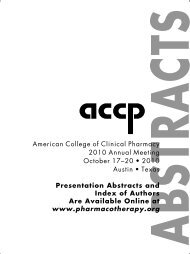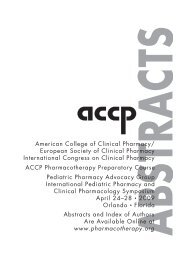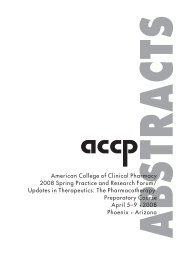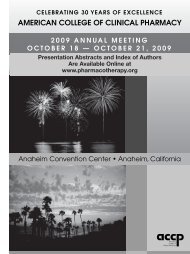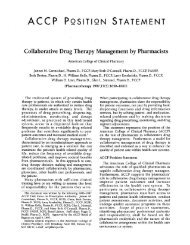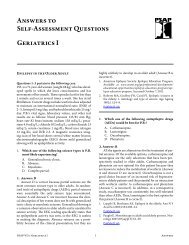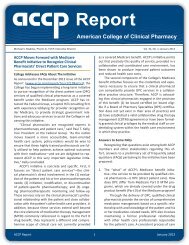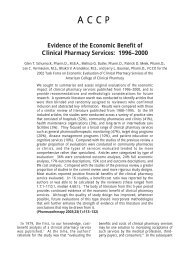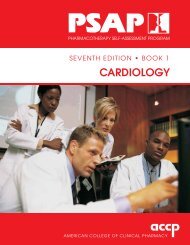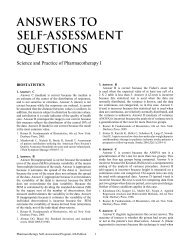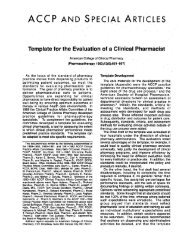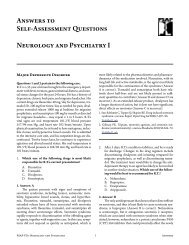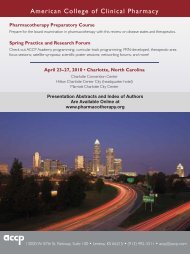Answers to Self-Assessment Questions - ACCP
Answers to Self-Assessment Questions - ACCP
Answers to Self-Assessment Questions - ACCP
You also want an ePaper? Increase the reach of your titles
YUMPU automatically turns print PDFs into web optimized ePapers that Google loves.
However, a 10-kg weight loss in a 1-week period is unlikely<br />
<strong>to</strong> result from inadequate calorie intake; thus, Answer A and<br />
Answer B are incorrect. Answer C (obtain a resting energy<br />
expenditure study <strong>to</strong> determine his caloric needs) is also<br />
incorrect because it again assumes that the weight loss is<br />
caused by inadequate calorie intake. The initial intervention<br />
for W.H., given the most likely reason for the weight loss, is<br />
<strong>to</strong> provide additional intravenous fluid either by increasing<br />
his PN volume or by adding additional intravenous fluids<br />
(Answer D); thus Answer D is the correct answer. W.H.’ s<br />
weight and s<strong>to</strong>ol output should be followed daily, and the<br />
additional fluid reduced <strong>to</strong> the previous volume once W.H.’s<br />
weight has returned <strong>to</strong> his usual weight and his s<strong>to</strong>ol output<br />
has decreased <strong>to</strong> the usual volume.<br />
1. Siepler J. Principles and strategies for moni<strong>to</strong>ring home<br />
parenteral nutrition. Nutr Clin Prac 2007;22:340–50.<br />
2. Messing B, Joly F. Guidelines for management of home<br />
parenteral support in adult chronic intestinal failure patients.<br />
Gastroenterology 2006:130:S43–S51.<br />
3. Jeppesen PB, Mortensen PB. Intestinal failure defined by<br />
measurements of intestinal energy and wet weight absorption.<br />
Gut 2000;46:701–6.<br />
31. Answer: B<br />
W.H.’s wife tells you that he has developed a tremor and<br />
is having hallucinations. These symp<strong>to</strong>ms are not normally<br />
seen in patients receiving home PN; thus Answer A (do<br />
nothing, but reassure W.H.’s wife that these symp<strong>to</strong>ms<br />
are normal) is incorrect. Hypermagnesemia can occur in<br />
patients receiving long-term home PN when receiving a<br />
trace element cocktail daily. Manganese is deposited in<br />
the basal ganglia, so hypermagnesemia results in various<br />
neurological symp<strong>to</strong>ms including those being experienced<br />
by W.H. However, other nutrient imbalances may also lead<br />
<strong>to</strong> similar symp<strong>to</strong>ms. Therefore, Answer B (have the home<br />
health nurse draw a basic metabolic panel, complete blood<br />
count, and serum manganese concentration) is the best<br />
intervention at this time, making Answer B the correct<br />
answer. Answer C (have the nurse draw a serum manganese<br />
concentration) is one of the appropriate interventions, but<br />
Answer C is not the best answer because other labora<strong>to</strong>ry<br />
tests should also be checked. Answer D (remove the<br />
trace element preparation from W.H.’s PN formulation) is<br />
incorrect. It would be premature <strong>to</strong> remove the trace elements<br />
from the PN formulation at this time. If hypermagnesemia<br />
is determined <strong>to</strong> be the cause of W.H.’s new neurological<br />
symp<strong>to</strong>ms, then the trace element preparation would have <strong>to</strong><br />
be removed, but zinc and perhaps chromium would need <strong>to</strong><br />
be added <strong>to</strong> the PN formulation <strong>to</strong> prevent a deficiency state.<br />
1. Dickerson RN. Manganese in<strong>to</strong>xication and parenteral<br />
nutrition. Nutrition 2001;17:689–93.<br />
2. Bertinet DB, Tinivella M, Balzola FA, de Francesco A, Davini<br />
O, Rizzo L, et al. Brain manganese deposition and blood levels<br />
in patients undergoing home parenteral nutrition. JPEN J<br />
Parenter Enteral Nutr 2000;24:223–7.<br />
3. Clark SF. Vitamins and trace elements. In: Gottschlick MM,<br />
DeLegge MH, Mat<strong>to</strong>x T, Mueller C, Worthing<strong>to</strong>n P, eds. The<br />
A.S.P.E.N. Nutrition Support Core Curriculum: A Case-based<br />
Approach – The Adult Patient. Silver Spring, MD: American<br />
Society for Parenteral and Enteral Nutrition, 2007, 129–59.<br />
32. Answer: A<br />
A 25-year-old woman (weight 42 kg, height 163 cm)<br />
with chronic intestinal pseudo-obstruction is admitted <strong>to</strong><br />
the hospital because of continued weight loss over the last<br />
2 years (maximum weight 60 kg). Eating causes abdominal<br />
pain, as did continuous jejunal feedings during her last<br />
hospitalization. Her symp<strong>to</strong>ms are typical of patients with<br />
chronic intestinal pseudo-obstruction. Some patients have<br />
severe small intestinal dysmotility with propulsion upward<br />
<strong>to</strong>wards the s<strong>to</strong>mach instead of downwards <strong>to</strong>ward the colon.<br />
The best plan for this patient is <strong>to</strong> plan for discharge home<br />
on PN therapy (Answer A), making Answer A the correct<br />
answer. Answer B (start high-calorie oral supplements) is<br />
incorrect because any type of oral feedings will produce<br />
the same symp<strong>to</strong>ms and will not be <strong>to</strong>lerated. Placing a<br />
transpyloric feeding tube and starting an elemental feeding<br />
formulation (Answer D) is incorrect because this therapy has<br />
already been tried and was not successful. Discharging her<br />
home with no nutrition support and waiting for her weight<br />
<strong>to</strong> decrease further (Answer C) is incorrect as she is already<br />
12 kg below her ideal weight. Further weight loss will likely<br />
occur and result in another hospitalization <strong>to</strong> initiate PN.<br />
1. Messing B, Joly F. Guidelines for management of home<br />
parenteral support in adult chronic intestinal failure patients.<br />
Gastroenterology 2006:130:S43–S51.<br />
2. Kelly DA. Intestinal failure-associated liver disease: what do<br />
we know <strong>to</strong>day? Gastroenterology 2006;S70–S77.<br />
33. Answer: C<br />
A 25-year-old man (weight 50 kg, height173 cm) has been<br />
receiving home PN for 2 years after being injured in a mo<strong>to</strong>r<br />
vehicle accident. He has SBS with 20 cm of residual small<br />
intestine and 50% of his colon. His medical his<strong>to</strong>ry includes<br />
intravenous drug abuse. His recent labora<strong>to</strong>ry results include<br />
a 4-fold increase in his alkaline phosphatase (ALK), alanine<br />
aminotransferase (ALT), aspartate aminotransferase (AST),<br />
and <strong>to</strong>tal bilirubin concentrations. The most appropriate<br />
response <strong>to</strong> the elevation in this man’s liver function<br />
tests (LFTs) is <strong>to</strong> obtain hepatitis serology and conduct a<br />
detailed drug his<strong>to</strong>ry looking for drug-induced causes of<br />
his labora<strong>to</strong>ry abnormalities (Answer C), making Answer<br />
C the correct answer. Answer A (reduce the intravenous fat<br />
emulsion in his PN formulation), Answer B (reduce both<br />
the intravenous fat emulsion and dextrose components of<br />
the PN formulation), and Answer D (discontinue his home<br />
PN therapy immediately) are incorrect because the cause<br />
of the elevated the LFTs must be determined before the<br />
correct therapy can be determined. This patient has risk<br />
fac<strong>to</strong>rs for hepatitis as well as PN-induced stea<strong>to</strong>sis and<br />
cholestasis. Additionally, with this patient’s degree of SBS,<br />
discontinuing his PN is not a practical option.<br />
1. Kelly DA. Intestinal failure-associated liver disease: what do<br />
we know <strong>to</strong>day? Gastroenterology 2006;S70–S77.<br />
2. Siepler J. Principles and strategies for moni<strong>to</strong>ring home<br />
parenteral nutrition. Nutr Clin Pract 2007;22:340–50.<br />
3. OKeefe SJ. Bacterial overgrowth and liver complications<br />
in short bowel intestinal failure patients. Gastroenterology<br />
2006;130:S67–S69.<br />
Gastroenterology and Nutrition <strong>Answers</strong><br />
42<br />
Pharmacotherapy <strong>Self</strong>-<strong>Assessment</strong> Program, 6th Edition



